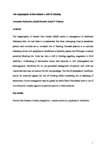The coagulopathy of liver disease: a shift in thinking
| dc.contributor.author | Ballantine, A | |
| dc.contributor.author | Martin, Daniel | |
| dc.contributor.author | Thakrar, SV | |
| dc.date.accessioned | 2021-08-23T08:29:46Z | |
| dc.date.available | 2021-08-23T08:29:46Z | |
| dc.date.issued | 2021-06-02 | |
| dc.identifier.issn | 0210-0258 | |
| dc.identifier.issn | 1759-7390 | |
| dc.identifier.uri | http://hdl.handle.net/10026.1/17728 | |
| dc.description.abstract |
<jats:p> The coagulopathy of chronic liver disease causes derangement of the results of traditional laboratory tests. As such, there is an expectation that when undergoing invasive procedures patients with cirrhosis are at increased risk of bleeding. Standard practice is to optimise laboratory values with prophylactic transfusions of platelets, plasma and fibrinogen to reduce perceived bleeding risk. There has been a shift in thinking regarding coagulation in patients with chronic liver disease, whereby a rebalancing of haemostasis occurs with reduction in both procoagulants and anticoagulants. Guidelines for the preprocedural management of patients with chronic liver disease are inconsistent and may not account for this new paradigm. The risk of prophylactic transfusion should be measured against the risk of bleeding while considering the rebalancing of haemostasis. Future management may be guided by whole blood viscoelastic tests or use of thrombopoietin receptor agonists to optimise patients in these scenarios. </jats:p> | |
| dc.format.extent | 1-9 | |
| dc.format.medium | Print-Electronic | |
| dc.language | en | |
| dc.language.iso | en | |
| dc.publisher | Mark Allen Healthcare | |
| dc.subject | Chronic liver disease | |
| dc.subject | Cirrhosis | |
| dc.subject | Coagulation | |
| dc.subject | Invasive procedure | |
| dc.subject | Prophylactic transfusion | |
| dc.title | The coagulopathy of liver disease: a shift in thinking | |
| dc.type | journal-article | |
| dc.type | Journal Article | |
| plymouth.author-url | https://www.webofscience.com/api/gateway?GWVersion=2&SrcApp=PARTNER_APP&SrcAuth=LinksAMR&KeyUT=WOS:000669782800016&DestLinkType=FullRecord&DestApp=ALL_WOS&UsrCustomerID=11bb513d99f797142bcfeffcc58ea008 | |
| plymouth.issue | 6 | |
| plymouth.volume | 82 | |
| plymouth.publication-status | Published | |
| plymouth.journal | British Journal of Hospital Medicine | |
| dc.identifier.doi | 10.12968/hmed.2021.0111 | |
| plymouth.organisational-group | /Plymouth | |
| plymouth.organisational-group | /Plymouth/Faculty of Health | |
| plymouth.organisational-group | /Plymouth/REF 2021 Researchers by UoA | |
| plymouth.organisational-group | /Plymouth/REF 2021 Researchers by UoA/UoA01 Clinical Medicine | |
| plymouth.organisational-group | /Plymouth/Users by role | |
| plymouth.organisational-group | /Plymouth/Users by role/Academics | |
| dc.publisher.place | England | |
| dcterms.dateAccepted | 2021-02-24 | |
| dc.rights.embargodate | 2021-12-2 | |
| dc.identifier.eissn | 1759-7390 | |
| dc.rights.embargoperiod | Not known | |
| rioxxterms.versionofrecord | 10.12968/hmed.2021.0111 | |
| rioxxterms.licenseref.uri | http://www.rioxx.net/licenses/all-rights-reserved | |
| rioxxterms.licenseref.startdate | 2021-06-02 | |
| rioxxterms.type | Journal Article/Review |


